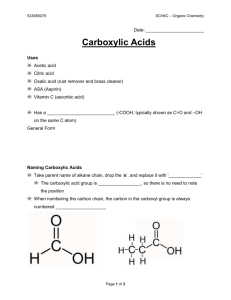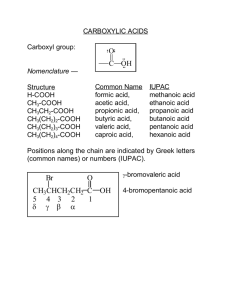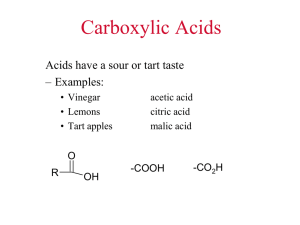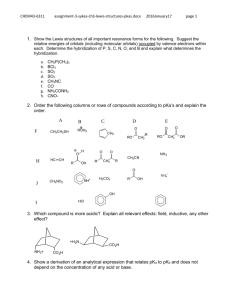Chapter 18 Carboxylic Acids
advertisement
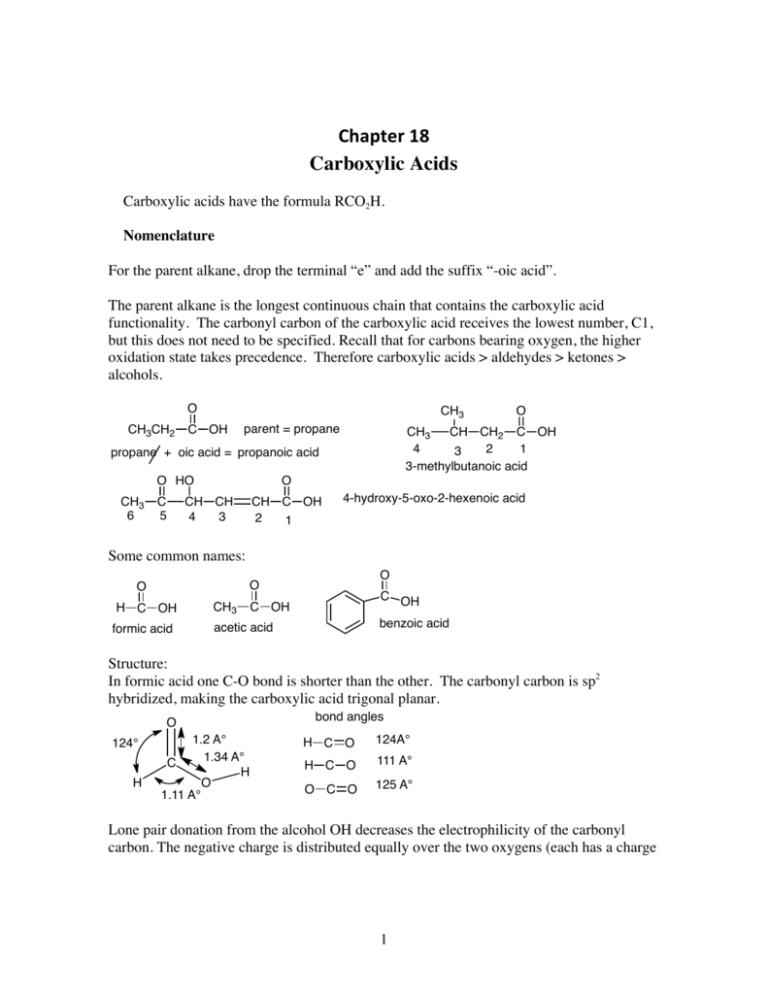
Chapter 18 Carboxylic Acids Carboxylic acids have the formula RCO2H. Nomenclature For the parent alkane, drop the terminal “e” and add the suffix “-oic acid”. The parent alkane is the longest continuous chain that contains the carboxylic acid functionality. The carbonyl carbon of the carboxylic acid receives the lowest number, C1, but this does not need to be specified. Recall that for carbons bearing oxygen, the higher oxidation state takes precedence. Therefore carboxylic acids > aldehydes > ketones > alcohols. O CH3CH2 CH3 C OH parent = propane CH3 CH CH2 C OH 4 2 1 3 3-methylbutanoic acid propane + oic acid = propanoic acid O HO CH3 6 C 5 O O CH CH 4 3 CH C OH 2 1 4-hydroxy-5-oxo-2-hexenoic acid Some common names: O O O H C OH formic acid CH3 C OH C OH benzoic acid acetic acid Structure: In formic acid one C-O bond is shorter than the other. The carbonyl carbon is sp2 hybridized, making the carboxylic acid trigonal planar. O 124° H 1.2 A° 1.34 A° C H O 1.11 A° bond angles H C O 124A° H C O 111 A° O C O 125 A° Lone pair donation from the alcohol OH decreases the electrophilicity of the carbonyl carbon. The negative charge is distributed equally over the two oxygens (each has a charge 1 of -1/2) and the bond lengths are the same, 1.25 A°, about mid-way between a single and double bond. C H O H C H O O O O O H C C H bond length 1.25 A° H O O In the conjugate base, both oxygens are the same length and the negative charge is equally distributed over both oxygens. Carboxylic acids have higher boiling points that alcohols or ketones due to intermolecular hydrogen bonding. Two sets of hydrogen bonds are possible. O HO O O b. p. 31° 80° O 141° 99° H O H H Two sets of intermolecular H-bonds O are possible. O Carboxylic acids containing four carbons or less are miscible with water. Acidity of Carboxylic Acids Carboxylic acids are the most acidic compounds that contain only carbon, hydrogen and oxygen. They are much more acidic that H2O (pKa 15.7) or alcohols, ROH (pKa ~ 16), but they are still fairly weak acids when compared to the mineral acids such as HBr (pKa 7) or HCl (pKa -5). Carboxylic acids have pKa’s of about 5 but this can be lowered considerably by electron withdrawing substituents. H CH3CH2 O H + O pKa 16 weaker acid Keq = 10-17 H CH3CH2 H O + H O ΔG = 91 Kj/mol pKa -1 H stronger acid Here the equilibrium is very unfavorable. As we know, the reaction proceeds in the direction of converting the stronger acid into the weaker acid. Here we see that the hydronium ion (H3O+) on the right is a much stronger acid (pKa -1) than the alcohol so the equilibrium lies way to the left. We can calculate the equilibrium constant by simply subtracting the exponents of the pKa’s and adjusting the sign according to where the equilibrium lies: (-)-sign for the equilibrium to the left and (+)-sign for the equilibrium to the right. 2 With acetic acid in water, we see that the equilibrium is still unfavorable but less so. H Keq = 10-17 O H + O CH3CH2 CH3CH2 H + H O pKa -1 H stronger acid O H pKa 16 weaker acid ΔG = 91 Kj/mol The free energy of ionization for acetic acid (+27 KJ/mol) is still unfavorable but much less unfavorable than it is form ethanol (+ 91 KJ/mol). This is due to (1) the resonance stabilization of the resulting carboxylic acid anion, as shown above, and (2) to the inductive electron withdrawing effect of the carbonyl carbon. We can use the Henderson-Hasselbalch equation to find the ratio of concentrations of an acid and its conjugate base. It is derived as follows. H H For: A H + O A [H3O+] [Conjugate base] Ka = H conjugate base H Acid H O + = [acid] [H3O+] [Conjugate base] [acid] Taking the log of both sides: log Ka = log [H3O+] + log [Conjugate base] [acid] Rearrange this to: = -log [H3O+] -log Ka + log [Conjugate base] [acid] Since pH is by definition –log [H3O+] and pKa is –log Ka, this expression is: pH - pKa + log [Conjugate base] [acid] This is the Hendreson-Hasselbalch Equation This is the Henderson-Hasselbalch equation. This can be rearranged to: pH - pKa = log [Conjugate base] [acid] [Conjugate base] or: [acid] 3 = 10(pH-pKa) Salts of Carboxylic Acids, RCO2- M+ These are named by taking the parent carboxylic acid, dropping the suffix “-oic acid” and adding the suffix “-ate”. The metal counterion is specified first. O C O C O- Na+ CH3 Cl sodium acetate CH3 O- Li+ CH2 CH O CH C O- K+ potassium 2-methyl-3-butenoate lithium p-chlorobenzoate Carboxylic acid salts are soluble in water if the molecular weight is not too high. If there are 12 – 18 carbons in the carboxylic acid salt then the behavior is unusual. For example sodium stearate (sodium octadecanoate) is semi-soluble and forms micelles. These are membrane-like structures that self-assemble in water into spherical shapes in which the polar head groups (-CO2-) are on the outside and the long, non-polar hydrocarbon chair are on the interior. O- Na+ sodium octadecanoate O polar headgroup Non-polar hydrocarbon chain -O -O 2C -O 2C CO2- 2C CO2-O spherical micelle 2C CO2-O 2C CO2-O 2C -O CO2- 2C -O 2C CO2-O 2C CO2- CO2- CO2- 4 The spherical shape exposes the minimum surface for a given volume. This is how soaps work. They form micelles. Grease is non-polar and gets enclosed in the hydrophobic interior of the micelle and so is washed away. Commercial detergents are similar to soaps except that they use synthetic head groups, like sulfates. 2+ O S -O O- O Na+ lauryl sulfate (sodium dodecyl sulfate) Substituents and Acid Strength Electronegative substituents near an ionizable hydrogen increase its acidity. Alkyl groups have little effect. CH3 O O O CH3CH2 C OH pKa 4.7 CH3CH C OH C OH CH3 pKa 4.9 pKa 4.8 Halogens at the alpha position increase the acidity due to the inductive effect of the halogen. The electronegative chlorines withdraw electron density from the alpha-carbon, giving it a partial positive charge and also they help to stabilize the resulting anion by dispersing the negative charge. O O CH2 C OH Cl Cl Cl pKa 2.9 Cl O C C H Cl Cl O Cl O CH C OH Cl C C OH Cl pKa 1.3 Cl Cl O C C pKa 0.9 O Cl The effect of the chlorine weakens as it is moved away from the alpha position. 5 O O CH3 CH2 CH C OH Cl CH3 CH CH2 Cl pKa 2.8 O C OH CH2 CH2 CH2 Cl pKa 4.1 C OH pKa 4.5 Note that there is also the field effect. This operates in the same direction as the inductive effect but the electronegative effect is communicated through the medium, usually the solvent. An electronegative substituent in a molecule polarizes the surrounding solvent molecules. This polarization is transmitted through other solvent molecules to the remote site. Substituents affect the entropy of ionization more than they do the enthalpy term. As we know, the free energy is the sum of the change in enthalpy or heat, ΔH°, and the change in entropy or disorder, -TΔS: ΔG° = ΔH° - TΔS°. For most carboxylic acids, the enthalpy term is close to zero for ionization and so ΔG° is dominated by the -TΔS° terms. Ionization is accompanied by an increase in solvation forces. This leads to a decrease in the entropy of the system. ΔS is negative so –(-ΔS) is positive. Carboxylate ions with substituents capable of dispersing negative charge impose less order on the solvent (water) and less entropy is lost when they are ionized. Ionization of Substituted Benzoic Acids: Electron withdrawing groups (EWG’s) increase acidity, especially at the ortho position. O C O OH C O C OH pKa 4.2 pKa 2.2 NO2 NO2 OH pKa 3.4 Dicarboxylic Acids: Oxalic acid has two pKa’s. The first one is lower than the second. The carboxylic acid functional group is a strong electron withdrawing group and we see that the first pKa is much lower than that of acetic acid. The carboxylate anion is not nearly as strong an electron withdrawing group and so the second pKa is much higher, not much lower than that of acetic acid. Note also that part of the increased acidity of oxalic acid as compared to 6 the oxylate anion is due to the statistical effect. There are two potential sites for ionization in oxalic acid, making the effective concentration of carboxyl groups twice as large. O O O O H O C C O H + O H H oxalic acid H O C C O + H O H pKa1 1.2 H O O O O O C C O H oxylate anion + O H H O C C O + H O H pKa2 4.3 H Note that the electron withdrawing effect of the carboxylic acid decreases as the distance between them increases. O O O H O C C O H HO C CH2 pKa 1.2 O O C O H HO C O (CH2)5 C OH pKa 4.3 pKa 2.8 Carbonic Acid Carbonic acid is unstable but exists in equilibrium with CO2 and H2O. Due to the two strong C=O bonds, carbon dioxide is more stable and the equilibrium greatly favors CO2 and H2O, with only a tiny amount of carbonic acid present. O O C O + 99.7% O H H HO C OH carbonic acid, hydrate of CO2 0.3% Carbonic acid is very important in blood chemistry. It carries CO2 away from the cells to the lungs where it can be expunged. There is an enzyme, carbonic anhydrase, that catalyzes the hydration of CO2, thereby effectively reversing the equilibrium so that it lies in favor of hydration. Carbonic anhydrase is said to be the perfectly evolved enzyme in that it is the fastest enzyme known. It can catalyze the hydration of 3.6 x 107 molecules of CO2 per minute! Carbonic acid is a weaker acid than acetic acid. This indicates that the hydroxyl group is actually an electron donating group (EDG). Remember that there are two effects operating here in opposition to each other. Oxygen, of course is more electronegative than carbon and so the oxygen withdraws electrons through the inductive effect but the oxygen lone pair can donate back to the C=O π−system. This resonance donation is stronger than the electron withdrawing inductive effect and so the overall effect of the oxygen is to release electrons to the electron deficient carbonyl. 7 O O H O C O H O C O H + O H bicarbonate H Resonance effect donates eltrons to the carbonyl carbon through the oxygen lone pair. H O H O C pKa1 6.4 H O H + O O H H O C O H Overall the resonance effect is stronger than the donating effect. Inductive effect withdraws electrons from the carbonyl carbon. The second pKa, as we would expect, is higher than the first one, since the oxygen anion is an even better donating group. O O O C O H + O H H H O H + O C O pKa2 10.2 H carbonate And the carbonate dianion (i.e. sodium carbonate) is a stronger base than bicarbonate. Sources of Carboxylic Acids Previous Methods for Preparations of Carboxylic Acids (1) Side chain oxidation of alkyl benzene derivatives. Potassium permanganate or chromic acid will oxidize any aryl side chain down to the carboxylic acid as long as there is at least one benzylic hydrogen. O H C R1 R2 KMnO4 C R1, R2 = alkyl, alkenyl, etc OH or H2CrO4 For example: O CH3 C OH 1. KMnO4, H2O, NaOH OCH3 NO2 2. H3O+ OCH3 NO2 8 (2) Oxidation of primary alcohols. R CH2 O KMnO4 OH R C OH or H2CrO4 O CH2 H2CrO4 OH C OH (3) Oxidation of Aldehydes. A variety of reagents will oxidize aldehydes to carboxylic acids, including chromic acid. O R C H [Ox] R C OH O O CH3CH2 O H2CrO4 H C CH3CH2 C OH (4) Oxidative cleavage of alkenes using ozonolysis with oxidative work-up. Recall that alkenes can be cleaved using ozonolysis and by using an oxidative work-up with a peroxide reagent we can form carboxylic acids. R2 R1 1. O3 C C H 2. H2O2, H2O H H O R2 C OH + HO C R1 O 1. O3 HO H O C C 2. H2O2, H2O OH O New Methods for Synthesis of Carboxylic Acids (5) Carbonylation of Grignard Reagents of Organolithium Reagents Grignard reagents, RMgX, or organolithium reagents, RLi, both react with carbon dioxide to give, after acidic work-up, a carboxylic acid with the addition of one extra carbon. As we saw earlier, Grignards and organolithium reagents react with carbonyls and carbon dioxide, as a dicarbonyl is an excellent electrophile. O RMgX + RLi + O C O R C O O- MgX+ H3O+ O- Li+ H3O+ O O C O R C R C OH O 9 R C OH R = alkyl, aryl, vinyl For example: Br O MgBr Mg C O C O O C + O- MgBr+ H3O OH THF (6) Hydrolysis of Nitriles Nitriles or cyano groups can be hydrolyzed to carboxylic acids in either aqueous acidic or aqueous basic conditions. R C O H3O+, H2O, heat N R C OH or NaOH, H2O, heat; then H3O+ CH3CH2 C N O 1. NaOH, H2O, heat 2. H3 CH3CH2 C OH O+ As we know, we can make alkyl nitriles by reaction of alkyl halides with a nitrile salt. This is a simple SN2 reaction that forms a new C-C bond in the process. Then we can hydrolyze the nitrile to the carboxylic acid derivative. This method is complementary to the carbonylation of Grignard or organolithium reagents and can be useful with molecules that have an acidic proton and so that would not be compatible with the strongly basic conditions of the Grignard or organolithium intermediate. CH3 CH2 Br NBS hv, ROOR HO HCN, H2O, EtOH HO N CH2 C K+ -:CN 1. NaOH, H2O, heat 2. H3O+ HO Acidic proton would destory a Grignard intermidiate but is not deprotonated by the weakly basic nitrile. O CH2 C OH HO We can also hydrolyze cyanohydrins, which can be made from ketones or aldehydes by nucleophilic attack of the nitrile on the carbonyl carbon. O CH3 C CH2CH3 1. Na+ -:CN 2. H3O+ OH CH3 OH C CH2CH3 C N H3O+, H2O heat CH3 C CH2CH3 O C OH 10 Reactions of Carboxylic Acids (1) Carboxylic acids can be converted to acid chlorides by heating with thionyl chloride, SOCl2. O O SOCl2 R C OH R C Cl heat + SO2 O Cl Cl S Cl O CH3CH2 O C OH + Cl S Cl CH3CH2 HCl + O- O S Cl S Cl O O CH3CH2 C O H strong Lewis acid Cl- + CH3CH2 HCl O Cl- O SO2 + C O H CH3CH2 C Cl S Cl C O H Cl O CH3CH2 C O H Cl (2) Carboxylic acids can be reduced to primary alcohols with lithium aluminum hydride. O LiAlH4 R C OH R CH2 OH THF O C OH LiAlH4 CH2 OH THF (3) Carboxylic acids can be converted to esters by reaction with alcohols in acidic conditions. O R C OH + H2SO4 R'OH O R C OR' H2O O O C + OH + HOCH2CH3 C H2SO4 The mechanism is as follows: 11 OCH2CH3 + H2O O C O H2SO4 C OH H OH OH C OH C OH OH O H HOCH2CH3 H2O H C O H + O O O H O CH2CH3 H OH C O H CH2CH3 CH2CH3 tetrahedral intermediate (hemi-acetal) CH3CH2OH HOCH2CH3 O CH2CH3 H C OH O CH2CH3 CH2CH3 O C OCH2CH3 The first steps are the same as the acetal formation. First we protonate the carbonyl carbon to make it more electrophilic and then the alcohol attacks to make, after proton transfer back to the ethanol solvent, the hemi-acetal. This is also called the tetrahedral intermediate. As we know, hemi-acetals are not stable. In this case, we now lose a molecule of water by first protonating one of the OH’s so as to re-form the strong C=O bond. Now, we can shorten the writing of this mechanism by combining some of the proton transfer steps. A shortened form of this is shown below. O H2SO4 C OH H O CH2CH3 H O HOCH2CH3 H O H HOCH2CH3 O C O H C OH OH H O CH2CH3 CH2CH3 C OCH2CH3 CH3CH2OH Notice that in the first step the carboxylic acid is protonated on the carbonyl oxygen rather than the hydroxyl group. This oxygen is more electron rich due to resonance. 12 H O O H O C O C C H O H O H H No resonance donation possible from the carbonyl oxygen since this would make a pentavalent carbon. Note also that these reactions are completely reversible and as we shall see in the next chapter, we can also cleave esters in dilute aqueous acid. This is called hydrolysis. We drive the equilibrium in favor of ester formation by using an excess of the alcohol under anhydrous conditions and we drive the reaction in favor of ester hydrolysis by using an excess of water. Lactone Formation We can form esters intramolecularly to form cyclic esters. These are called lactones. These are favorable when we have a 4- or 5-hydroxy carboxylic acid that can cyclic to form a five- or six-membered ring. O O HO CH2 4 CH2 3 CH2 2 C OH 1 H+ α β 4-hydroxybutanoic acid 5 CH2 4 CH2 3 CH2 2 4-butanolide (or butyrolactone) This is a γ−lactone γ O O HO CH2 O C OH 1 α H+ O 5-pentanolide δ β This is a δ-lactone γ 5-hydroxypentanoic acid The mechanism is as shown below. H2SO4 O HO CH2 CH2 CH2 CH2 C OH O H H2tSO4 CH2 C OH CH2 OH CH2 CH2 H O CH2 O C O H CH2 CH2 CH2 H2O O CH2 C O CH2 CH2 CH2 13 H H H O CH2 O C H O CH2 CH2 -OSO H CH2 3 H O CH2 C O CH2 CH2 CH2 + H2O Decarboxylation of Carboxylic Acids with a β-Carbonyl Carboxylic acids that have a 1,3-relationship with a strong electron withdrawing group such as a carbonyl will lose carbon dioxide on heating. This is called a decarboxylation reaction and as we will see in a future chapter it is very useful in synthesis. The mechanism involves a six-membered ring transition state in which a C-C bond is broken. There is a relatively high energy barrier for this cleavage but the overall reaction is favorable thermodynamically since we are breaking a C-C bond and forming a much stronger C=O bond. O CH3 O O C CH2 C OH O heat 150-200°C CH3 O malonic acid heat 150-200°C HO C CH3 HO O C CH3 C CH2 CO2 + CO2 H H H CH3 + O HO C CH2 C OH O C CH3 O C O O CH3 C O CH3 OH2 C enol + C H H H3O+ 6-membered ring transition state O CH3 C CH3 keto form 14 O C O

